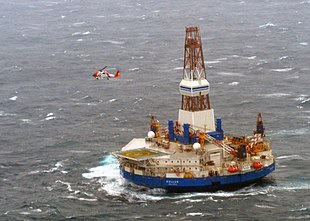
The Beaufort Sea is a marginal sea of the Arctic Ocean, located north of the Northwest Territories, the Yukon, and Alaska, and west of Canada's Arctic islands. The sea is named after Sir Francis Beaufort, a hydrographer. The Mackenzie River, the longest in Canada, empties into the Canadian part of the Beaufort Sea west of Tuktoyaktuk, which is one of the few permanent settlements on the sea's shores.

Chukchi Sea, sometimes referred to as the Chuuk Sea, Chukotsk Sea or the Sea of Chukotsk, is a marginal sea of the Arctic Ocean. It is bounded on the west by the Long Strait, off Wrangel Island, and in the east by Point Barrow, Alaska, beyond which lies the Beaufort Sea. The Bering Strait forms its southernmost limit and connects it to the Bering Sea and the Pacific Ocean. The principal port on the Chukchi Sea is Uelen in Russia. The International Date Line crosses the Chukchi Sea from northwest to southeast. It is displaced eastwards to avoid Wrangel Island as well as the Chukotka Autonomous Okrug on the Russian mainland.

CCGS Terry Fox is a Canadian Coast Guard heavy icebreaker. She was originally built by Burrard-Yarrows Corporation in Canada in 1983 as part of an Arctic drilling system developed by BeauDril, the drilling subsidiary of Gulf Canada Resources. After the offshore oil exploration in the Beaufort Sea ended in the early 1990s, she was first leased and then sold to the Canadian Coast Guard.

MSV Fennica is a Finnish multipurpose icebreaker and offshore support vessel. Built in 1993 by Finnyards in Rauma, Finland and operated by Arctia Offshore, she was the first Finnish icebreaker designed to be used as an escort icebreaker in the Baltic Sea during the winter months and in offshore construction projects during the open water season. Fennica has an identical sister ship, Nordica, built in 1994.

The question of whether to drill for oil in the Arctic National Wildlife Refuge (ANWR) has been an ongoing political controversy in the United States since 1977. As of 2017, Republicans have attempted to allow drilling in ANWR almost fifty times, finally being successful with the passage of the Tax Cuts and Jobs Act of 2017.

USCGC SPAR (WLB-206) is a United States Coast Guard Juniper-Class seagoing buoy tender home-ported in Duluth, Minnesota. The ship maintains aids to navigation in the Twin Ports and Great Lakes.
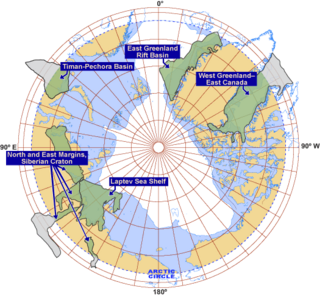
The exploration of the Arctic for petroleum is considered to be quite technically challenging. However, recent technological developments, as well as relatively high oil prices, have allowed for exploration. As a result, the region has received significant interest from the petroleum industry.
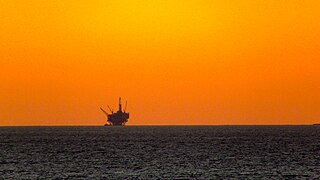
Offshore drilling is a mechanical process where a wellbore is drilled below the seabed. It is typically carried out in order to explore for and subsequently extract petroleum that lies in rock formations beneath the seabed. Most commonly, the term is used to describe drilling activities on the continental shelf, though the term can also be applied to drilling in lakes, inshore waters and inland seas.

Canada's early petroleum discoveries took place near population centres or along lines of penetration into the frontier.
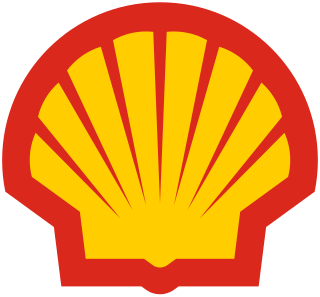
Shell plc is a British multinational oil and gas company headquartered in London, England. Shell is a public limited company with a primary listing on the London Stock Exchange (LSE) and secondary listings on Euronext Amsterdam and the New York Stock Exchange. It is one of the oil and gas "supermajors" and by revenue and profits is one of the largest companies in the world, ranking within the top 10 of the Fortune global 500 since 2000. Measured by both its own emissions, and the emissions of all the fossil fuels it sells, Shell was the ninth-largest corporate producer of greenhouse gas emissions in the period 1988–2015.

Vladimir Ignatyuk is a Russian icebreaking anchor handling tug supply vessel. She was built by Burrard-Yarrows Corporation in Canada in 1983 as Kalvik as part of an Arctic drilling system developed by BeauDril, the drilling subsidiary of Gulf Canada Resources. After the offshore oil exploration in the Beaufort Sea ended in the early 1990s, she was sold to the Canadian shipping company Fednav in 1997 and renamed Arctic Kalvik. In 2003, she was purchased by Murmansk Shipping Company and transferred to Russia.
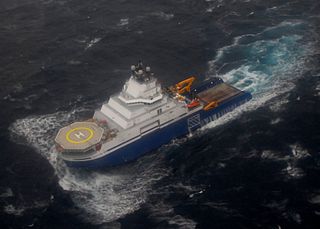
Aiviq is an American icebreaking anchor handling tug supply vessel (AHTS) owned by Edison Chouest Offshore (ECO). The $200 million vessel was built in 2012 by North American Shipbuilding in Larose, Louisiana and LaShip in Houma, Louisiana. She was initially chartered by Royal Dutch Shell to support oil exploration and drilling in the Chukchi Sea off Alaska where the primary task of the vessel was towing and laying anchors for drilling rigs, and oil spill response.

MSV Nordica is a Finnish multipurpose icebreaker and offshore support vessel. Built in 1994 by Finnyards in Rauma, Finland, and operated by Arctia Offshore, she and her sister ship Fennica were the first Finnish icebreakers designed to be used as escort icebreakers in the Baltic Sea during the winter months and in offshore construction projects during the open water season.

Arctic Challenger is a barge which has been converted by Superior Energy Services for use in the Arctic drilling operations of Shell Oil Company. This barge is designed to function as a "novel engineering solution" which they refer to as an Arctic Containment System to respond should a blowout event occur at drilling sites in the Beaufort or Chukchi Seas. According to testimony provided to Senator Mark Begich on 11 October 2012, Coast Guard Rear Admiral Thomas Ostebo said the certification for the Shell spill barge Arctic Challenger to operate in Alaska was given on the 10th of October at the Bellingham, Washington shipyard where it was constructed. Ostebo is commander of the Coast Guard’s 17th district, which covers Alaska.

Protests against Arctic drilling began in Seattle in 2015 in response to the news that the Port of Seattle authority made an agreement with Royal Dutch Shell to berth offshore drillships and semi-submersibles at the Port's Terminal 5 (T5) during the off-season of oil exploration in Alaskan waters of the Arctic. Hundreds of protesters took to Elliott Bay in kayaks, rafts, and other small boats, both as a demonstration and to interrupt docking of Shell's Polar Pioneer semi-submersible drilling vessel at Terminal 5. The waterborne demonstrators were dubbed kayaktivists by social and news media.
Single steel drilling caisson is a drill barge that was built for year-round oil exploration in shallow ice-covered waters in the Beaufort Sea. The unit, initially named SSDC and later shortened to SDC, was converted from an old oil tanker in the early 1980s. It has been used to drill a total of eight oil wells on both Canadian and U.S. continental shelves, the most recent in 2006.
Miscaroo was an icebreaking anchor handling tug supply vessel built by Vancouver Shipyards for BeauDril, the drilling subsidiary of Gulf Canada Resources, in 1983. She was part of a fleet of Canadian icebreakers used to support offshore oil exploration in the Beaufort Sea. In the 1990s, the vessel was acquired by Canadian Marine Drilling (Canmar) and renamed Canmar Miscaroo. In 1998, she was purchased by Smit International and served in the Sakhalin oil fields as Smit Sakhalin until 2017 when the 34-year-old icebreaker was sold for scrapping in China.
Ikaluk is an icebreaking anchor handling tug supply vessel built by Nippon Kōkan K. K. Tsurumi Shipyard in Japan for BeauDril, the drilling subsidiary of Gulf Canada Resources, in 1983. She was part of a fleet of Canadian icebreakers used to support offshore oil exploration in the Beaufort Sea. In the 1990s, the vessel was acquired by Canadian Marine Drilling (Canmar) and renamed Canmar Ikaluk. In 1998, she was purchased by Smit International and served in the Sakhalin oil fields as Smit Sibu. Since 2009, she was owned by FEMCO Management and in 2012 was given back her original name. Ikaluk was sold to China in February 2018 and later renamed Beijing Ocean Leader.
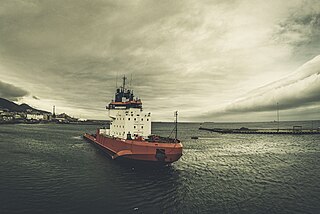
Kigoriak is a Russian icebreaking anchor handling tug supply vessel. Built by Saint John Shipbuilding & Dry Dock Company for Canadian Marine Drilling (Canmar) in 1979 as Canmar Kigoriak, she was the first commercial icebreaking vessel developed to support offshore oil exploration in the Beaufort Sea.
Tagiuk Provider, formerly Arctic Endeavor, is a 205 ft (62 m) 1500-ton ice-class flat-topped deck cargo barge adapted to being a clam-shell crane scoop mining platform for placer gold mining in the Bering Sea off Nome, Alaska, United States. The barge, a gold dredge, is owned by Tagiuk Gold, which previously ran scuba-diver-operated suction dredges for seafloor gold mining in the area. Tagiuk Gold is run by miner Andrew Lee, whose business running the barge is partially crowdfunded. Tagiuk Provider was profiled in an episode of Bering Sea Gold, at which time, it was the largest scoop dredge operating off Nome.
